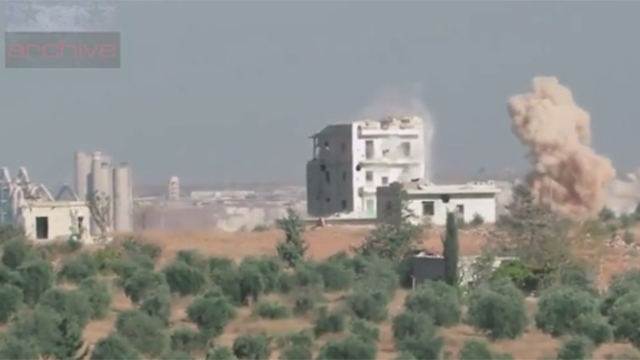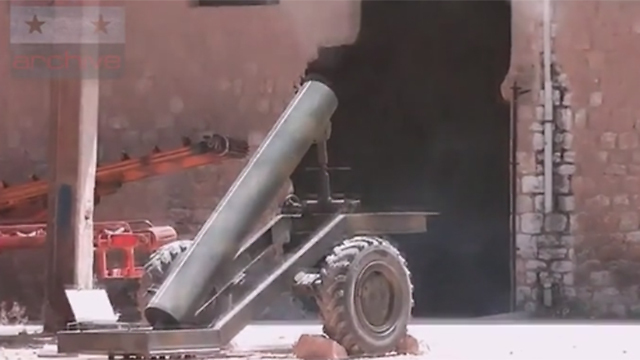Analysis: A massacre by chemical weapons in Syria in 2013 led to Russia and the US forcing Assad to give up on his arsenal of non-conventional weapons. But recent reports suggest that the regime is using Sarin gas against the opposition – and that the rebels themselves are using chemical weapons as well.
New reports emerging from the ground in Syria suggest that despite Assad’s assertions in 2013 that he had disposed of his chemical weapons arsenal, his regime continues to fight in the civil war using non-conventional means.
The war, which will enter its sixth year in two months’ time, has no end in sight. The number of victims of the conflict – killed, injured, traumatized, etc – continues to rapidly increase and intensive efforts to bring the two sides to the negotiating table have yet to bear real fruit.

While rebel organizations such as the Free Syria Army and Jabhat al-Nusra are waging a war against President Bashar Assad’s regime as well as against rival rebel groups, Russia and other countries are also deeply invested in the bloody conflict.
Russia, for example, has taken up arms on the side of the regime in Damascus, while the United States is supporting the moderate rebels and, in a limited way, the Assad government in its fight against Islamic State.
A while back, US President Barack Obama declared Syria’s use of chemical weapons a “red line.” But the massacre by chemical weapons in a Damascus suburb in summer 2013 did not push Obama into military action against Syria – rather, he opted for the diplomatic process.
This option, at Russia’s initiative, centered around the proposal that Syria dismantle its chemical weapons arsenal. Some of these non-conventional weapons were destroyed and others taken outside the country’s borders.
Through this initiative Russia succeeded in keeping Assad in power and allowed for the Americans to show the world that it had managed to rid Syria of chemical weapons without excessive bloodshed.
Chemical routine
But did Syria actually get rid of its chemical weapons? On paper it would appear so; in reality, things seem otherwise. The use of chemical weapons against civilians, rebels and regime forces has become routine.
Opposition figures in Syria occasionally provide reports on the regime’s use of chemical weapons. Although the number of casualties involved is not at summer 2013 levels, when more than 1,300 were killed according to estimates, the statistics should still be a cause of concern for the international community.

A member of the Syrian opposition familiar with the subject of chemical weapons use in the civil war told Ynet that there are indeed indications that the regime has used Sarin gas within the last year.
“Chlorine gas was used last year in Idlib and its suburbs in the north-west of the country,” the source, who worked in the Center for Documentation of Violations in Syria, said. “Islamic State also used mustard gas in Marea, a suburb of Halab, in the north.”
The center’s annual report estimates that between the first use of chemical weapons in Syria and August 2015, they have killed 3,118 people – the vast majority of whom were civilians and nearly two-thirds of whom were children. The center also estimates that the number of those injured by chemical weapons in Syria in the same period stands at 12,867.
A UN delegation that released its own report on the Syrian civil war last December states that it found indications that a number of people in Syria had been exposed to the lethal Sarin gas or a similar chemical agent.
Sarin gas seeping into the war
The Syrian government denies that it is using chemical weapons and accuses the opposition of being the ones fighting with non-conventional materials. Damascus’ claims are fiercely rejected by moderate rebel groups that are backed by the West.
Western officials quoted by Reuters estimate that the rebel groups are not capable of using Sarin gas. Since the Syrian regime carried out the chemical massacre in 2013, it has been accused of using chlorine gas while shelling opposition targets across the country. Reports of the regime’s use of Sarin gas are now being added to those accusations.
Most of the reports have been published by Arabic media outlets sympathetic to the opposition, including the Saudi Al-Sharq al-Aswat and Al-Jazeera. According to Syrian opposition figures, the regime’s bombardment of the town of Muadamiyet al-Sham, next to Damascus, killed at least five people and wounded many dozens more. It is claimed that Sarin gas was used during the onslaught. Videos were published online that documented seemingly large numbers of wounded, although there is no official confirmation or concrete evidence that the people shown were exposed to Sarin gas.
The Syrian National Coalition, the political umbrella organization of the Syrian opposition, condemned what it termed a “new chemical massacre.”

“The (UN) Security Council must take steps against Syria under clause 7 in order to protect civilians, as stipulated in Resolution 2118, following the use of Sarin gas near Damascus,” the organization said. It also claimed that chemical weapons had again been used in the same area of Syria that the 2013 massacre had been carried out – even after a ceasefire between the regime and rebel forces in the area, for humanitarian reasons.
An effective and lethal weapon
The Syrian regime has its own version of events and in Syria, it is difficult to establish who is telling the truth and who is lying. Each side has its own interests and benefits from demonizing its rivals. It is also evident that the Syrian regime no longer holds the significant arsenal of chemical weapons that it once did and is instead occasionally using a limited stock leftover from before. Even though Assad recognizes the international community’s huge sensitivity to the use of chemical weapons, it is difficult for him to refrain from using them completely because of their efficacy on the battlefield.
Although most fingers point at the regime, other actors in the civil war have also resorted to using chemical weapons. The Islamic State group has documented its own use of non-conventional materials in Halab.
Numerous recent testimonies report IS’s use of mustard gas in Marea, not far from the Turkish border. The terror organization has deployed the same weapon against Kurdish forces in Iraq.
But IS is not alone. Other rebel organizations, defined as “moderate,” also occasionally use chemical weapons against regime targets, albeit not lethal agents such as Sarin gas.
The international community is aware of the situation. But given that all red lines were crossed in Syria long ago, provided a massacre of civilians is not underway the criticisms remain relatively minimal.
Despite the harrowing pictures that continue to emerge from Syria, however, the number of casualties of chemical weapons still pales into comparison with the number of victims of conventional arms.
As reported by Ynetnews
